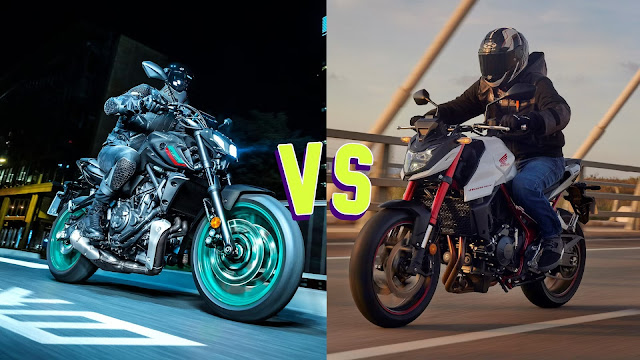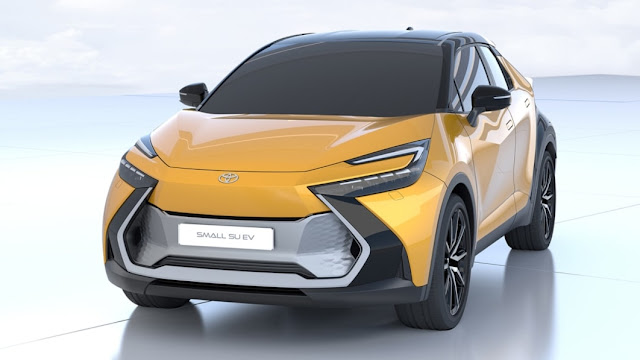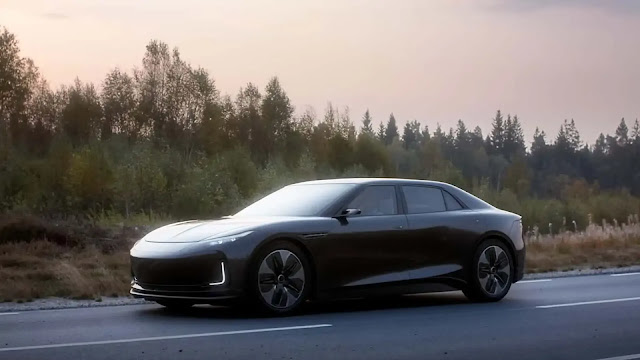Revving Rivalry: Honda Hornet vs. Yamaha MT-07 – Clash of the Naked Titans
Honda Hornet vs. Yamaha MT-07: Which is the Ultimate Naked Bike?
Nine seasons as the reigning champion, yet the elusive tenth crown remains out of reach. The Yamaha MT-07 is a bit like Valentino Rossi, whose quest for that elusive tenth title – in this case, as the best-selling naked bike in Europe– has been thwarted by the arrival of the Honda CB 750 Hornet. Let's pit them against each other, point by point.
When we look at sales figures in the medium naked bike segment, this year marks the first time since its debut in 2014 that the Yamaha MT-07 isn't at the top. Taking its place is the new Honda Hornet CB750, deliberately positioned as the anti-MT-07 in terms of features and price. Tokyo's new naked bike has accomplished its mission: it dethroned the "dark side of Japan" motard. But what exactly happened? Was it the allure of the name, the novelty effect, the higher technical specs, or something else? To find out, we've pitted the MT-07 against the Hornet, armed to the teeth.
What Is the MT-07?
There was the MT-01 and the MT-03 before, but the MT-07 is the cornerstone of the "modern" MT family, along with its "dark motard" sibling, the MT-09, which arrived a few months earlier at the end of 2013. While it was groundbreaking back then, it remains original in its appearance today. It's less motard in its riding style compared to its three-cylinder sibling, but it shares two things with it: the joy of riding and a super-competitive price.
Simple, fun, and accessible, the MT-07 achieved immediate success, accounting for nearly 40% of its segment in Europe, just as intended. It appeals to new riders and those on their first motorcycle and is also popular among female riders. Proudly "no-frills," the first edition even offered ABS as an option, but electronics never became a part of it. Only this year have we seen the addition of a TFT dashboard and optional quick-shifter. Nevertheless, this lack of tech didn't stop the MT-07 from winning over generations of riders.
Yamaha MT-07
Starting at €8,259
What Is the Honda Hornet CB750?
Arriving amid discussions and controversies for inheriting the legacy of the most popular and beloved 4-cylinder naked bike of the 90s and 2000s, the new CB750 Hornet has swept them aside with the force of a winning project in terms of performance, features, and value for money. It represents a significant leap forward for Japanese production.
While it may lack the inline-4 engine's high-pitched "buzz," the compact single-cam twin willingly explores the high revs and offers more gratifying sporty performance than its predecessor. Moreover, the Hornet boasts more refined suspension and brakes compared to the average in its segment, and it's highly tech-savvy: special engine coatings, patents for distribution and intake ducts, and a comprehensive electronic package, featuring ride-by-wire and separate adjustment of power, engine braking, and traction control with integrated anti-wheelie.
Honda Hornet CB750
Starting at €8,290
Chassis: The MT-07's Build
The MT-07's design is extremely rational, leaving little room for extravagance. Yamaha included everything necessary but nothing more, and they've cleverly hidden areas where cost-cutting was applied. A simple diamond frame with steel tubes surrounds the engine, non-adjustable suspension with a traditional fork (which in recent versions is styled to look upside-down), a well-designed rear suspension linkage, 298 mm discs with axial calipers (which only became semi-monoblock from 2021), and a general inclination towards cost-saving, evident in levers, pedal controls, fork clamps, and other areas. Notably, the test version, equipped with numerous accessories including levers, turn signals, and exhaust, is less Spartan in this regard. On the bright side, the aluminum swingarm is a standout feature, box-sectioned and curved on the right side, left exposed by the low-mounted exhaust.
Yamaha has poured all its legendary know-how is in selecting the dimensions and harmonizing the elements to create a bike that's easy and intuitive to ride, yet fun like never before in this category. To this day, the MT-07 remains one of the shortest bikes in its segment in terms of wheelbase (1,400 mm) and trail (90 mm) and one of the lightest, weighing just 184 kg ready to ride (with a 14-liter fuel tank). Suspension travel is 130 mm on both ends, and it boasts generous rubber: Michelin Road 5 tires at 120/70-17" front and 180/55-17" rear.
Regarding electronics, as we know, the MT-07 remains "analog," offering only ABS. However, from this year, it comes with a brilliant and clear 5-inch TFT display that can be connected to a smartphone for call and message notifications. An optional quick-shifter is also available, but it lacks ride-by-wire.
Chassis: What Does the Hornet Offer?
Like the MT-07, the Hornet CB750 is the first model from a platform destined to be offered in various variants, including the first one, the Transalp 750, which has already debuted successfully. For this reason, it had to accept some compromises, but in practice, they don't have much of an effect. The most obvious difference lies not in the frame or engine, but in the shared trapezoidal headlight between the two. With an identical price point to the MT-07, and aiming to offer superior specs, it's clear that the Hornet has also pursued an absolutely rational project: if the Yamaha is no-frills, the Honda has only a few frills.
Inside, you'll find a diamond frame with steel tubes that wrap around the engine, a welded subframe made of tubular steel, and a box-sectioned steel swingarm. The single exhaust runs on the right side. However, the suspension boasts two more refined units compared to the Yamaha, particularly the inverted 41 mm Showa SFF-BP fork with separate functions. The Showa rear shock is linked to a lever and adjustable for preload. Suspension travel is 130 mm and 150 mm front and rear, respectively. The brakes offer better specs too, with petal discs measuring 296 mm paired with radial-mount Nissin calipers. In terms of tires (Michelin Road 5 here as well), Honda has opted for a narrower rear, with a 160/60 R17, enhancing agility without affecting weight, which is virtually the same as the Yamaha at 190 kg ready to ride (but with a 15.7-liter fuel tank).
In terms of chassis dimensions, the Hornet is slightly larger but generally in line with the MT-07. It has a wheelbase of 1,420 mm compared to 1,400 mm, a trail of 99 mm compared to 90 mm, and a distribution of stiffness that feels rather similar. The riding position is notably different, with the Hornet offering a more classic naked feel. The handlebars are less elevated, and the tank tapers better between the rider's legs. In terms of normal road use, the Hornet doesn't seem significantly more powerful than the MT-07. Instead, its engine feels a bit smoother at lower revs in higher gears.
However, once you push beyond 7,000 rpm, the Honda twin continues to rev and accelerate confidently, accompanied by a delightful induction sound. Meanwhile, the Yamaha's CP2 engine starts to struggle and loses its momentum. Keeping the engine at high revs allows you to appreciate all the extra power of the Hornet, even though it demands more attention to ride in these conditions.
While both bikes offer excellent stability at high speeds, it's the fork that struggles more on the Hornet, making it lose some of its usual poise and ease of use. In this regard, the Honda is 100% Honda: you get on it, and it's yours, even though it doesn't explicitly encourage playful riding like the Yamaha does.
In terms of onboard electronics, despite the Yamaha's lack of customization options, we found Honda's electronics to be somewhat intrusive. Not so much in their intervention, but rather because once ABS and especially Traction Control come into play, they disengage with a noticeable delay compared to expectations. Simply passing over a patch of gravel or a patch of grass can cause the warning light to flash for many meters, while the engine loses power and, more importantly, support, especially in cornering or even just maneuvering, which can be quite annoying.
In practical terms, when it comes to performance that can actually be enjoyed on the road, the Hornet has a less significant advantage than the specs would suggest. As we've seen in previous comparisons, the MT-07 remains a tough contender even against bikes with more horsepower. The Honda has a different personality, equally intuitive and immediate but more "disciplined" compared to the MT-07. Even in terms of passenger comfort, which is somewhat limited in both cases, the Hornet isn't more accommodating than its rival.
Conclusion: Hornet or MT-07?
If we look at the spec sheets, there's no doubt that the new Hornet, at the same price, offers significantly more in terms of performance and features than the MT-07. Honda deserves credit for this effort, as it's undoubtedly one of the key points they emphasize to convince potential customers.
Performance and features are undeniably on the Hornet's side. However, in everyday road use, even with some sporty concessions, the MT-07 doesn't truly show its vulnerabilities. Its "fun-bike" DNA continues to shine, and its design remains original, with the addition of the impressive TFT display further modernizing the bike. Without a doubt, the Hornet would perform better on the track, but on the road, these two bikes move in substantial harmony, and the choice between them remains a matter of personal preference. Design choices play a significant role here, with Yamaha's lines and graphics appearing more appealing to a younger audience, while Honda seems to be making inroads with a more mature demographic.
In both cases, as demonstrated by the bikes in our test, there's ample room for customization with the extensive range of accessories offered by the manufacturers. The battle seems destined to continue for a long time to come…




Comments